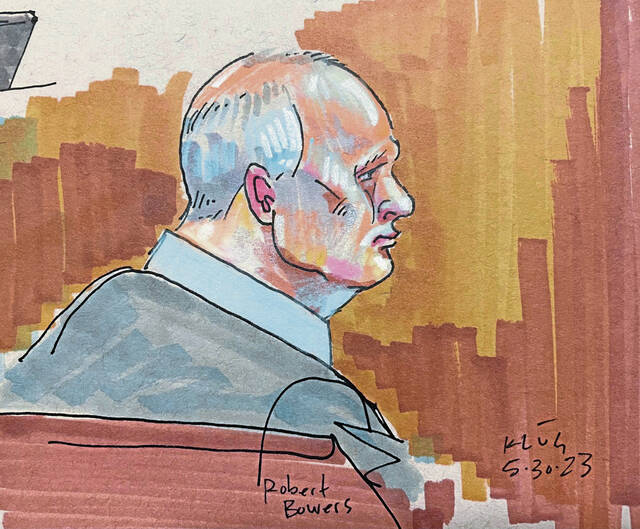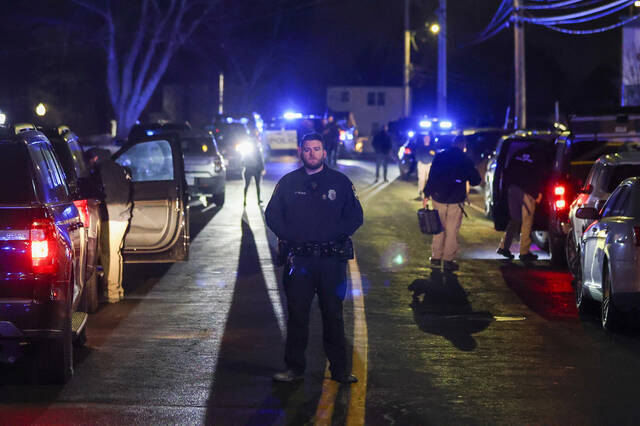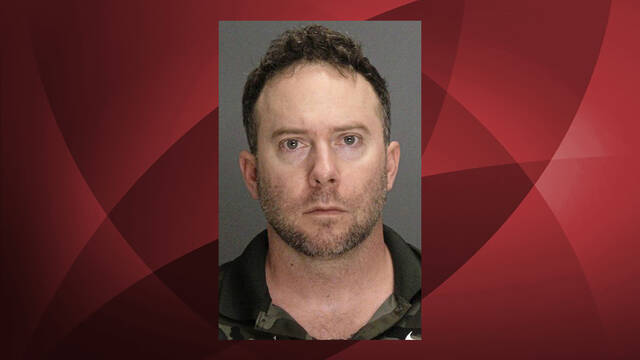“He moves through the world under a vague feeling of threat and paranoia.”
“He is quick to agitation.”
“Active psychosis makes it impossible for him to assess stimuli and read the world appropriately.”
All of those findings, an expert in neuropsychiatry and epilepsy testified Wednesday, mean that Robert Bowers could not stop himself from carrying out the targeted attack on the Tree of Life synagogue in Pittsburgh’s Squirrel Hill once he had formulated his plan to do so.
“I don’t think there was a choice being made here,” Dr. Siddhartha Nadkarni testified. “I don’t think there was an ability to make a choice.”
Nadkarni, who is board-certified in six specialties and spent 25 years at New York University, spent all of Wednesday’s court proceedings testifying for the defense in the eligibility phase of Bowers’ trial.
On June 16, a jury found Bowers, 50, of Baldwin, guilty of all 63 federal counts against him in the mass shooting at the Squirrel Hill synagogue in which 11 congregants were killed.
The victims were members of the Tree of Life-Or L’Simcha, Dor Hadash and New Light congregations. They included Rose Mallinger, 97; Bernice Simon, 84, and her husband, Sylvan Simon, 86; brothers David Rosenthal, 54, and Cecil Rosenthal, 59; Dan Stein, 71; Irving Younger, 69; Dr. Jerry Rabinowitz, 66; Joyce Fienberg, 75; Melvin Wax, 87; and Richard Gottfried, 65.
The government is seeking the death penalty. In this phase of the trial, the prosecution must prove that Bowers is eligible for capital punishment. To do so, the government must prove intent and at least one of four aggravating factors.
The defense argued during opening statements in this phase of the trial on Monday that Bowers should not be eligible for capital punishment because diagnoses of schizophrenia and epilepsy made it impossible for him to form the requisite intent.
Nadkarni, when pushed on cross-examination by the government to state that same conclusion, did not do so.
Instead, he said he was uncomfortable with the word “intent.”
“I don’t think he’s incapable of planning it out, but I think his reasons for carrying it out are not reliable in his brain,” Nadkarni told U.S. Attorney Eric Olshan. “His brain works in a way that misinterprets information, and he’s paranoid.”
Bowers, he said, misperceives things that aren’t threatening and finds that they are.
“He is unable to make decisions using proper judgment based on delusional beliefs,” Nadkarni said.
Bowers carried out the attack after spending months reading and posting antisemitic, hate-filled content on the far-right social media site Gab.com.
Nadkarni told the jury that he spent about four hours conducting a neurological evaluation of Bowers in September 2021. Following his assessment, as well as extensive brain imaging conducted at UPMC, he diagnosed him with schizophrenia and epilepsy. It was the first time anyone had made any such diagnoses.
In support of his findings, Nadkarni cited suicide attempts, involuntary commitment for psychiatric treatment, and delusions that he learned about through medical records, police records and his own interview of Bowers.
He painted a picture of a man troubled with mental health issues and brain dysfunction most of his life.
Bowers had “a very serious mental health history from a very young age,” Nadkarni said.
He told the jury that Bowers attempted suicide several times.
However, on cross examination, Nadkarni conceded that there was only one documented suicide attempt. When Bowers was 17, he drank grain alcohol until he passed out, and then the alcohol lit on fire from a cigarette, scarring his arm.
Records also showed that Bowers made a “suicidal gesture” at age 10, although they did not specify in what way.
In 1985, when Bowers was 13, he was admitted to McKeesport Hospital for “violent behavior at home” after he threw an inflammable liquid at his mother and tried to light it and then “threatened to kill himself,” according to medical records that defense attorneys displayed for jurors.
“It’s very unusual to see such a severe psychiatric history in a child,” Nadkarni said.
Records also showed that Bowers was involuntarily committed for psychiatric treatment three times — at the former St. John’s Hospital in Brighton Heights in 1988, at the former St. Francis Hospital in Lawrenceville in 1990, and at St. Clair Hospital in Mt. Lebanon in 2004.
In the latter incident, Bowers, who had been worried about potentially becoming homeless, put a loaded shotgun in his mouth. He was admitted to St. Clair for three days and then released without any follow-up treatment.
Bowers also told Nadkarni he suffered from visual and auditory hallucinations from a young age. A record from Children’s Hospital of Pittsburgh when Bowers was 5½ years old showed that he had a “febrile illness” — a fever with a temperature of at least 104.9 degrees — and “began to hallucinate.”
“He had something wrong with his brain at a very young age,” he said.
The doctor described the defendant during their interview as displaying a flat affect — a way of speaking in an emotionless way — and said he was “tremendously slow in his processing.”
A flat affect is a sign of possible psychosis, Nadkarni said, adding that Bowers appeared “rigid and obsessive and repetitive,” which typically indicates frontal-lobe dysfunction in the brain.
Nadkarni spoke repeatedly about dysfunction in both the defendant’s frontal and temporal lobes.
The frontal lobe, he said, controls executive function such as decision-making, planning, judgment and comportment.
The temporal lobe controls emotional regulation, hearing, memory and language processing.
The EEG of Bowers’ brain confirms that dysfunction, as well as Nadkarni’s diagnoses of schizophrenia and epilepsy, he said.
Relative to his finding of schizophrenia, Nadkarni said Bowers has a thought disorder, delusions and cognitive impairments. He said he did not know what caused Bowers to develop it.
“We don’t really know exactly what causes schizophrenia,” Nadkarni said.
“Negative symptoms” of the disorder include social and cognitive deficits, isolation, poor self-care and loss of affect. “Positive symptoms” include delusions and hallucinations.
Nadkarni said Bowers likely had some of these symptoms when he attacked the synagogue in 2018.
“I think he was living on the margins. He was isolated,” the doctor said.
Bowers was at risk of becoming homeless, the doctor said, and he never functioned in his career at the level his intellect could have allowed. Both of those, he continued, can be indicative of schizophrenia.
Nadkarni also testified at length about brain anatomy, and explained that epilepsy can cause cognitive dysfunction and psychological issues.
About 80% of people with epilepsy suffer from depression, he said, and people with epilepsy frequently have concurrent mental health issues.
While many people associate violent convulsing with epileptic seizures, he said, the “vast majority of seizures … are much smaller and much blander, and can often be missed,” especially when the person lives alone and is isolated like Bowers was.
Although there are no documented instances of seizure in Bowers’ history, Nadkarni believes that an incident Bowers described as a panic attack while driving in New Jersey could have been a seizure. He also referenced an episode when Bowers was a child when he described waking up in the middle of the night and being unable to move — called sleep paralysis.
During cross-examination that lasted nearly three hours, U.S. Attorney Eric Olshan pressed Nadkarni at length about what appeared to be minor errors in his report on Bowers’ brain — including mislabeling his findings or reversing things like increased or decreased metabolism. The prosecutor spent an inordinate amount of time questioning him about blue arrows Nadkarni placed on the EEG read-out to demonstrate the slowing of Bowers’ brain wave patterns.
Nadkarni explained that he placed the arrows on the images for his own use to be able to describe at what points of the test the results were abnormal.
They did not change his finding that Bowers’ EEG showed significant dysfunction in the frontotemporal parts of his brain.
“This is a sign that the brain doesn’t work normally, in general,” Nadkarni said.
He also noted that the UPMC physician and the government expert who read Bowers’ EEG reached the same findings.
Nadkarni used the word “delusions” in his report, yet listed only one instance.
During his incarceration following the synagogue shooting, Bowers experienced a “profound delusion” and a “belief system that had to do with his body,” Nadkarni said.
Bowers believed that ink from his Butler County Prison uniform was leaching into his body and then coming out in his identification wristband, making it redder. It then was flowing back into his pen, he told Nadkarni.
Olshan questioned Nadkarni why he used the plural when there was only one instance of a delusion.
Nadkarni answered that he found Bowers’ answers when asked about relationships and families were so unusual that he considered them “subtly delusional material.”
Bowers spoke often during their interview about numbers, reciting his grandfather’s ATM PIN code, license plate numbers from people he knew and even the model number of his mother’s first computer decades ago.
“He had this sort of psychotic obsession with these numbers,” Nadkarni said. “His belief in the importance of these numbers is false. He’s convinced all these numbers are important to him.
“I found that to be odd and thought-disordered.”
Nadkarni admitted on cross-examination that he did not ask Bowers questions about the 2018 shooting, saying that he was not asked to do so when retained by the defense.
“It was not a big topic for us to talk about,” he said.
Nadkarni’s notes reflected that, when Bowers did speak of the attack, he said he was “in the war now.”
“They were just silhouette targets,” Bowers told the doctor about the victims. “He didn’t see these people like people.”
Bowers expressed antisemitic tropes, such as Jews drinking blood and killing children, Nadkarni said. The defendant also talked about HIAS, the former Hebrew Immigrant Aid Society. None of that went into Nadkarni’s report, but Olshan raised it in his cross-examination.
He also questioned Nadkarni about a psychiatric evaluation completed on Bowers at Allegheny County Jail three days after his arrest.
During that exam, Bowers told Dr. Peter Hauber that he was not suicidal and had only attempted suicide once when he was 17.
He denied having problems with sustained depression and told Hauber that immigrants posed a threat to white people in the United States.
Bowers also told Hauber that he had last worked in July 2017 as a long-haul truck driver and had been living off his savings since then.
He described his lifestyle as “fine and pretty relaxing since then.”
Of being incarcerated, Bowers said, “’I am going to probably be here forever, but at least in here, I do not have to worry about food.’”
Nadkarni said those statements to Hauber — showing indifference and nonchalance — support his diagnoses.
“I think it speaks to how broken his brain was, actually,” he said. “If he was planning to carry out an attack, and he said life is fine and pretty relaxing, that seems like a disconnect.”








